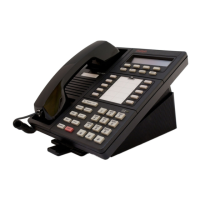MERLIN LEGEND Communications System Release 6.1
Feature Reference
555-661-110
Issue 1
August 1998
Features
Page 587Remote Access
setting is ignored. For networked Release 6.0 and later systems
(Hybrid/PBX mode), barrier codes should be required; they are then
required for non-network calls into these systems via the public switched
telephone network or via the remote access code in the non-local dial plan.
Network call routes (UDP or ARS) use the default COR FRL and do not
use barrier codes. For additional details, see “Tandem Switching” on page
671.
■ Allowed List Assignment. Does not apply to Allowed List Assignment. Do
not
assign Allowed Lists as default COR settings.
■ Disallowed List Assignment. Assigns Disallowed Lists; use when remote
access users are not restricted from making local and/or toll calls. When a
Disallowed List is assigned, remote users cannot dial the specific numbers
included on the list. Disallowed Lists are set up for all system users (see
“Allowed/Disallowed Lists” on page 36
). When barrier codes are not used,
Disallowed Lists can be assigned to all remote access lines/trunks and
cannot be assigned to individual lines/trunks. When barrier codes are used,
Disallowed Lists are assigned to individual barrier codes. For networked
Release 6.0 and later systems (Hybrid/PBX mode), a Disallowed List
should be assigned; it is applied both to non-network calls into these
systems via the public switched telephone network and to network-routed
calls. For additional details, see “Tandem Switching” on page 671
.
■ Automatic Callback (Autoqueuing). The factory setting prevents a remote
caller who reaches a busy pool (Hybrid/PBX only) or extension from using
the Automatic Callback feature to request a pool or extension. The factory
setting can be changed to allow remote users to use Automatic Callback to
request busy pools or extensions. Automatic Callback assignment applies
to all remote access users and cannot be assigned to lines/trunks or barrier
codes on an individual basis. For networked Release 6.0 and later systems
(Hybrid/PBX mode), the Automatic Callback setting does not apply to
network calls that are routed across a system using ARS or UDP routing.
Callback features only work for lines and trunks on a local system. If a
remote access caller calls into a system and attempts to make a non-local
extension call or an ARS call that is routed to another networked system,
the Callback setting only permits or does not permit Callback when local
tandem trunks are unavailable; calls queue for Route 1 only. For additional
details, see “Tandem Switching” on page 671
.
Considerations and Constraints 40
Under applicable tariffs, the customer is responsible for any charges incurred
through the remote use of system facilities. To prevent unauthorized use of the
system’s outside lines by remote callers, see the Security Alert on page 579
.
Beginning with Release 3.0, combining mismatched line/trunk types (touch-tone
and rotary) does not cause a call to fail.
Rotary-dial telephone users are routed to a QCC assigned as a backup extension.
From there, callers are connected to the system operator.

